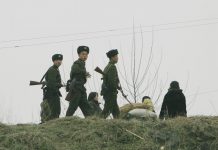
In the wake of the South Korean government’s battle to prevent the spread of foot-and-mouth disease following an outbreak in three farmhouses in the cities of Anseong and Chungju earlier this year, North Korean livestock industry insiders have reported to Daily NK that North Korea is also struggling with a nationwide spread of the disease outbreak that began in the middle of January.
Multiple sources across three regions of North Korea reported that foot-and-mouth outbreaks in their respective areas have led to the death of many work cattle on collective farms.
During the early stage of the outbreak, it was assumed that the cows had died from malnutrition. But as the number of deaths increased, a veterinary disinfection agency launched an investigation and concluded that it was foot-and-mouth disease.
Foot-and-mouth disease is a type 1 viral, legally-recognized communicable disease that occurs in cloven-hoofed animals such as cows, pigs, goats, dears and camels involving the formation of blisters around the animal’s mouth and feet, with a fatality rate between 5 – 55%.
Foot-and-mouth disease is highly contagious, infecting the respiratory tract and transmitted through the air, with one infected animal sufficient to rapidly infect the rest of the herd. For cows, the incubation period is only 3 to 8 days and once infected, symptoms appear quickly. There is no cure, but tissue culture vaccines are used as a preventive method.
South Korea’s intelligence agency has also received information on the outbreak in North Korea and is monitoring the spread of the disease and the country’s response. Foot-and-mouse disease can spread through the air, and if it reaches the border region, the South Korean authorities will have to enact measures to deal with it.
“To prevent the spread of foot-and-mouth disease, North Korea’s veterinary inspection agency declared the 7th of this month as a national disinfection day and ordered multi-lateral disinfection efforts focusing on collective farms […] although some farms have expressed concerns that due to lack of supplies, disinfection measures might be ineffective and the disease will spread,” a source in Jangang Province told Daily NK.
Another source in North Pyongan told Daily NK that ” in the Uiju and Chongju regions close to Yalu River, the outbreak killed many cows but there were no proactive measures and the farms continue to be affected,” he said.
A source in Ryanggang Province reported similar developments in that province’s Samsu region.
When a foot-and-mouth disease outbreak is detected in South Korea, a nationwide ban on the transport of all cloven-hoofed animals is issued and livestock in farms around the outbreak are preventatively culled. When the disease first emerged this winter in Anseong, the South Korean Ministry of Agriculture conducted a nationwide vaccination of all cows and carried out disinfection measures focusing on livestock farms and transportation routes.
North Korea also quarantines outbreaks of foot-and-mouth disease and announces measures for disinfection and cure. Pig and cow carcasses are buried and cloven-hoofed animals are banned from sale in the markets.
However, the vast majority of collective farms lack appropriate supplies such as disinfectants and quicklime. They also lack an understanding of the disease itself and frequently expect the disease to resolve itself naturally while in quarantine.
According to defectors who worked in the industry, when outbreaks occur in North Korea, the livestock protection agency is responsible for setting up restrictions on livestock transport. In addition, local heads of people’s committees and rural management committees in the affected cities and counties hold meetings to discuss preventive measures.
Through state media in 2011, North Korea revealed that around 10,000 pigs and cows were infected with foot-and-mouth disease and several thousand heads of livestock died. A national emergency veterinary disinfection committee was organized and a nationwide ‘emergency disinfection’ was declared.
A defector who was previously a high ranking official in the livestock industry spoke to Daily NK about the recent developments. “First, it’s important to improve the animals’ nutrition to develop resilience against the disease […] a nationwide emergency anti-epidemic period should be declared and a disinfection process should be carried out in livestock breeding facilities, collective farms, and livestock farms and continually monitored,” he said, asking that his name not be used for the protection of his family still in the North.
“If foot-and-mouth disease occurs in North Korea, it can affect the South as well, so emergency aid to assist the North with preventive measures should be considered,” the defector added. “It will be most effective if the South and North directly meet and discuss the assistance because it will take too long to ask for help from an international agency. The associated investigations and the transport of materials takes a long time.”
*Translated by Yongmin Lee



















